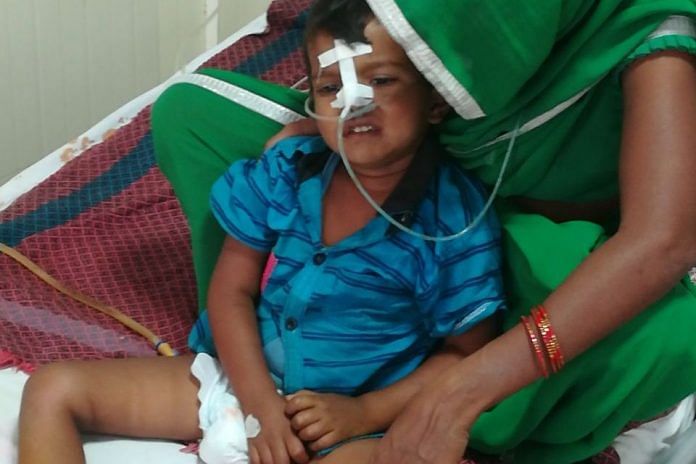The death of more than 70 children in Gorakhpur’s BRD Medical College this month has been blamed on a variety of causes, including, controversially, on a disruption in oxygen supply.
But a study by the Indian Council of Medical Research (ICMR) could shed new light on the tragedy.
An ICMR research paper, accessed by ThePrint, documents a major lapse in the encephalitis vaccine programme which may have gone unnoticed amid the blame game over the crisis.
Gorakhpur and the rest of eastern UP have a history of encephalitis outbreak, with the National Vector Borne Diseases Control Programme (NVBDCP) reporting 26,686 cases in the past seven years.
Official records of the medical college, obtained by social activist Rajesh Mani Tripathi, reveal that over 8 per cent of the deaths in the hospital in 2016 were caused by Japanese Encephalitis (JE).
The 2015 ICMR study, undertaken in the Gorakhpur division, has shown how a majority of the children surveyed missed the second dose of the JE vaccine due to improper implementation of the immunisation programme.
According to medical experts, the JE vaccine is a ‘killed’ or inactive vaccine – one that is produced by killing the pathogen. This is less effective than a ‘live’ vaccine, created by reducing the virulence of a pathogen, but still keeping it viable. The JE vaccine needs to be administered in two doses, and sometimes even three.
“The media hasn’t focused much on this issue. The lapse in the vaccine programme is something that should be talked about. The JE vaccine must be given in two doses, at the interval of 28 days,” said Dr R.N. Singh, chief campaigner, Encephalitis Eradication Movement in Gorakhpur.
Singh said that two mass vaccination drives were carried out in UP – in 2005 (65 lakh) and 2010 (75 lakh). “Now, CM Yogi Adityanath has promised approximately 1.30 crore vaccines. But the problem lies in implementation,” he said.
The ICMR study exposes a massive failure in administering these vaccines. It says the two-dose vaccine strategy was introduced in 2013, with a suggestion that the first dose (JE-1) be given between the ages of nine and 12 months, along with measles-containing vaccine (MCV-1) while the second one (JE-2) should be administered between the ages of 16 and 24 months, along with diphtheria/oral polio vaccine booster and MCV-2.
The paper shows how three-fourths of the mothers responded positively to their children being administered the first dose while around 60 per cent of children failed to receive the second dose. Many women reported that they were asked to bring their child for vaccination in the next session.
This ICMR survey tends to attribute this vaccination failure to superstitions prevalent amongst health workers and lack of awareness among public health officials.
It also highlights how people were harbouring a notion that administering multiple vaccinations at the same time can burden the child’s immune system and increase the risk of side-effects.
The fact though is that simultaneous administration of different vaccines only increases the chances of achieving the ‘complete immunisation’ target.
However, some experts offer a different explanation about the causes of encephalitis.
“There are myriad causes of acute encephalitis syndrome (AES), with JE being one of them,” said Dr Sheffali Gulati of the department of paediatrics, AIIMS.
“We have to understand that AES itself is not the diagnosed disease, but a clinical condition that can be attributed to a number of viruses, bacteria, parasites or even auto-immune causes. There are even kids coming to me with auto-immune symptoms.”



